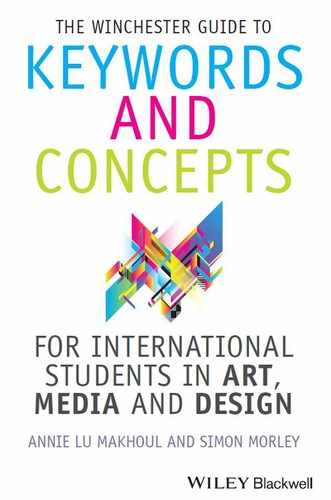PART A
DEFINING PRINCIPLES

THE WESTERN EDUCATIONAL STYLE
Art, media and design are terms widely used to define a group of disciplines that share important characteristics but that are different in significant ways. Learning in these subjects aims to develop your aesthetic sensibility and your capacity to be creative, as well as your intellectual and analytical skills. The material outcomes of engagement with these fields are also varied. But they require the development of particular mental and practical abilities.
If you come from a country outside the West, the style, methods and expectations of learning art, media and design will certainly be different from those familiar to you from studying in your own country.
Western educational institutions value clear articulation of an argument or interpretation and sustained support of an argument. Rather than relying on dogma, dictates or the arguments of the powerful, you must learn to defend your views and modify them in the face of criticism or challenges to your position. This means giving great importance to the linearity, clear articulation and rational form of your argument. In particular, educational institutions foreground the importance of what you are adding to a given reading, situation, theoretical set of concerns, interpretation and so on.
The role of critical thought in Western teaching also sets it apart from other intellectual traditions. Critical thinking allows for the ability to adapt to and engage with new information, new circumstances and new or emergent facts and conditions in a creative, problem-solving capacity. This encourages approaches that do not simply rely on standard methods, but also approaches that do not necessarily reject or throw them out either.
Western educational institutions therefore rely heavily on independent study and thought. They encourage critical, reflexive, non-linear and imaginative approaches to problem-solving, to the organisation of knowledge in general, and to the dissemination of such knowledge.
CONVERGENT AND DIVERGENT THINKING
You will be expected to constantly engage in creative thought, problem-solving and cooperative teamwork, and show a willingness to be experimental. You must employ ‘divergent’ as well as ‘convergent’ thinking.
The natural response in any given situation where decisions must be made is to leap to the simplest, least time-consuming and resource-heavy solution as quickly as possible. This is convergent thinking, or the ability to reduce problem-solving to a few similar ideas. Divergent thinking, in contrast, is the ability to generate many different ideas in response to a given problem, and as a result involves phases of critical thinking, a willingness to attempt multiple solutions to a given problem and an ability to recognise that unsuccessful solutions are as important to the thinking process as successful ones.
Divergent thinking is the ability to see many possible answers to a question and many possible ways to interpret a question. It involves thinking laterally, not just in linear or convergent ways. It therefore encourages the production of multiple answers, not just one answer.
Divergent thinking isn’t exactly the same thing as creativity. Creativity is the process of having original ideas with recognisable value. But, while divergent thinking isn’t necessarily about originality, it does encourage a capacity for creativity, which is essential. In studying art, media and design, both convergent and divergent thinking processes are required. For creative problem-solving, they aid the movement from the idea stage to the execution stage. The Western art and design institution is devised to optimally encourage within you this combination of convergent, divergent and creative thinking.
As a result of the general requirements and goals outlined above, forms of thinking that involve rational and analytical skills are developed in art, media and design courses, but these are not the only skills taught. Other forms of thinking – which involve practical thinking, motor-skills coordination and exploration of alternative situations within which the idea of being ‘correct’ gives way to broader issues of value – are also characteristic of the teaching and learning process. The study and practice of art, media and design develops and improves your intellect through critical creative awareness.
